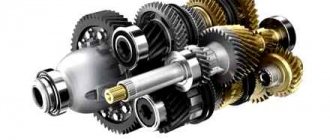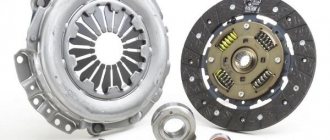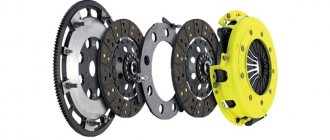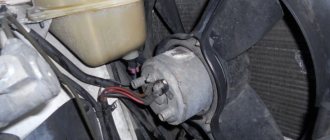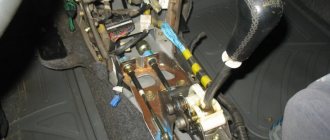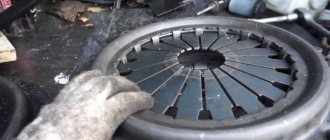- home
- car transmission
- …
As you already understand, we will talk specifically about a manual “box” and about shifting gears (or rather, not shifting) on it. I have quite a lot of experience in this area; I personally repaired cars such as VAZ 2114, VAZ 2110 (and the 10th family in general). To say that there are global differences between foreign cars, there really aren’t any! So if your speed is not cut off, then the reasons may be similar. In general, the article will be useful, at the end, as usual, there is a video...
A fairly large number of such questions come to me, especially from novice drivers of our VAZs! Especially with front-wheel drive, because in rear-wheel drive cars the lever was installed in the manual transmission itself. I want to answer everyone right away - the problem of non-inclusion may not always be cardinal! Often it’s a small matter, something just got loose or unscrewed from time to time, as a rule, this happens in 50% of cases.
Therefore, I will try to break the material into two large components - simple and complex faults.
I suggest starting with simple faults.
Gearbox linkages and rods
I remember I was “infuriated” on the VAZ 2114 by the fact that the gearbox lever was swinging from side to side like a “spoon in a glass”; I always wanted to make it stiffer, in some way. But there was only one way, to climb down the car and play with the scenes and rods. In principle, they can be released, tightened, the lever can be adjusted for tilt, etc. In general, I played around, but I noticed that if I press the lever too hard to the left, the ability to engage gear (first and reverse) disappears. This manifests itself when the car is not running, I’m already silent about the running engine.
Often the slides break, or they fly out of the fastenings, or the wear is simply enormous and they need to be replaced (this happens with high mileage). The very first thing we do is climb under the car and look at them.
Types of faults in manual transmissions of cars
The internal structure of the mechanical gear shift mechanism has its own characteristics, and its malfunctions can be divided into both breakdowns of the box itself and malfunctions of the transmission mechanism.
In order to be able to restore the car’s operation if any type of malfunction occurs, you should detect them in time and know the basic techniques for eliminating them. This is especially important if the breakdown occurred on the highway, on the road - then it will be important to resume the operation of the car until a visit to a repair specialist.
Let us list the main manifestations of malfunctions.
How to detect a malfunction?
The most common manifestations of malfunctions in the operation of manual transmissions include the following:
- The occurrence of extraneous noise when the handle is positioned in neutral;
- Noises when turned on, as well as when starting work;
- Difficulty when changing gears;
- The gear is switched off without affecting the shift lever;
- There is oil leakage from the transmission.
Drive and clutch cables
For rear-wheel drive models (VAZ 2101 - 2107), the gears are engaged hydraulically. That is, when you press the clutch, the fluid pushes the piston, which in turn pushes the clutch fork, which retracts the disc. For front-wheel drive models (VAZ 2108 - 2115), there is no hydraulic connection; everything is done here by mechanics, or rather by the clutch cable, which is connected to the pedals. If your slave cylinder leaks on a rear-wheel drive car or the cable breaks on a front-wheel drive car, the car will not engage in gear. The “fork” simply won’t work. We just check and replace damaged parts.
Methods for engaging first gear
So, if the modes in your vehicle are difficult to engage and you have already understood the reasons and theory, then let’s move on to the most important thing - methods for engaging first gear. The simplest method in this case would be to activate first gear while driving the car. You need to push the unit selector forward without any effort and do this until the corresponding synchronizer comes into operation. However, it should be noted that this method is relevant for most passenger vehicles and some trucks.
It should be taken into account that this cannot be done in most old trucks, since the design of the unit itself does not allow this, since they simply do not have synchronizers. In addition, you need to take into account that this method of activating the first speed is hardly relevant if the synchronizer on your vehicle has already exhausted its service life. This will simply be impossible.
Double car re-gas
Then the driver will only have to wait a while until the car practically stops in order to turn on the desired speed. Or use force to engage the gearshift lever. In principle, neither the first nor the second method can be called the optimal solution to such a problem. As practice shows, it is best to use the same old-fashioned method with re-gasping.
You can find out how to do this below:
- So, while driving in second gear, start depressing the clutch pedal.
- When you press the pedal, move the gearbox selector to the neutral position. Having done this, you can disable the clutch pedal.
- Then, when the pedal is completely lowered, you need to lightly press the gas with your right foot, pressing the pedal. In this case, pay attention to the tachometer, which shows the number of revolutions. You need to increase the revolutions to two and a half thousand per minute, that is, the needle should be at the number 2,500. Here, pay attention to one important nuance - the greater the difference in angular speeds of the mating gears of the box, the higher the number of revolutions needs to be raised. That is, 2,500 is the minimum, add gas if necessary.
- Then depress the clutch pedal again.
- Next, the box selector should be moved to the initial mode activation position, that is, first speed. Here, also pay attention to the fact that if the selector does not enter the required position correctly, then most likely you simply did not give enough gas. If this is the case, then repeat the steps, only add more gas.
- As a result, you need to release the clutch pedal smoothly, not abruptly. If you did everything correctly, the gearbox lever will move to the required position without any problems, shocks or extraneous sounds.
If you were unable to do this, then do not be discouraged - rarely does anyone manage to perform a double gas change the first time. By repeating the procedure several times, you will be able to remember everything that needs to be done to correctly engage the first speed. Actually, the same methods allow you to activate first gear when driving in third, for example, if in an emergency you need to brake the engine. In this case, the higher the driving speed, the longer you will need to wait for the synchronizers to help you. Or you need to press on the gas more.
But do not regard double throttling as a way out of the situation. This method can be called a temporary solution, but the unit will still have to be repaired. Since replacing synchronizers is a rather complex process, we recommend that you seek help from specialists. If you still decide to perform this procedure yourself, then the instructions provided below will be useful to you.
Loading …
Changing synchronizers
Replacing gearbox elements is carried out in several stages. We will not describe them in detail, since all actions are individual for each individual car.
Moreover, if you have never encountered such a procedure, you are unlikely to be able to perform it yourself:
- First you need to remove the gearbox from its installation location. To do this, use the recommendations in the service manual or search our resource - here you can find several instructions. The dismantled gearbox is thoroughly cleaned of dirt and dust.
- After this, you should remove the clutch cable retainer.
- Next, unscrew the four nuts that secure the rear cover of the unit; move it to the side.
- After this, unscrew the screw securing the fifth speed fork. Then turn it on, to do this you need to move the synchronizer clutch down with the fork. This must be done in such a way that the coupling splines are together with the gear. Having done this, you should activate either the third or fourth speed.
- Then you need to unscrew the nut that secures the input shaft. To be able to move it out of place, pull the key firmly, since it is most likely tightened with force. Carry out similar actions with the nut that secures the secondary shaft.
- Next, lift the fifth speed gear and remove it with the synchronizer and the secondary shaft fork. Please note: the clutch should not move from the hub at this point. Installation of new elements is carried out in the reverse order. You need to be as careful as possible. As you can see, in general the process is quite complex and responsible, so do not bother replacing synchronizers without experience.
Engine mounts
I personally have never had this happen, but many people write that this is a fairly common problem. Actually, the problem is this: the engine hangs on cushions, the gearbox is connected to it (manual transmissions, by the way, have their own cushions). It happens that the fastening breaks, or it unscrews. The engine or “box” may sag, the scenes may break, or they will hit something.
THEN there is another not very serious problem - these are pillows! If the programs don’t turn on, then we watch them.
These malfunctions, AS I THINK, ARE NOT PROBLEMS AT ALL! Anyone can identify them on pits or lifts, and this is done quite quickly. Personally, I came across rockers and cables, using the example of a VAZ, a clutch cable.
However, if you have checked everything, and the gears do not engage with the engine running. Then it’s worth looking at the box itself and the accompanying attachments. Let's move on to complex faults.
Transmission shafts
This is one of the rarest reasons, but it should not be excluded.
So, the gearbox shafts themselves fail. For example, second or fifth gear refuses to engage. The degree of wear can be determined only after dismantling the transmission and completely opening the elements. The shafts are not sharpened, but replaced with new ones. That's all.
Clutch fork
It’s rare, but it happens, for example, I had such a problem once on a VAZ 2105; the fork itself that retracted the clutch disc broke. Apparently it was not of very good quality. Why am I writing this down as a complex problem, because in order to replace it, you often need to remove the entire box, and this is no longer easy! Especially on front wheel drive. ALTHOUGH now people's “masters” in garages change it without removing the manual transmission.
Why haven't they abandoned manual transmissions yet?
Now, probably, many newcomers thought - “oh yes, “mechanics”, but who needs it, but now everyone drives an automatic transmission, and in general its days are numbered.” This is not entirely true, because this option has a lot of fans and real advantages, I won’t list them all, after all, we already thought - which is better than an automatic transmission or a manual transmission , but I will list some of the most significant ones:
- Price. As a rule, this option is 40 - 80,000 rubles cheaper than its automatic counterpart
- Fuel consumption, no automatic option has yet come close to it (but already quite a bit)
- Strength
- Simplicity of design
- Withstands heavy loads (accepts large torques )
- Temperature (difficult to overheat)
That is why this option is now used on many trucks, heavy SUVs, and many passenger cars. In general, it is premature to write off this unit, and now a version is being developed without a clutch pedal, that is, something like a semi-automatic transmission is switched manually, but there are no pedals.
Release bearing
The clutch fork is connected to the release bearing; it is this bearing (under the influence of the fork and your foot) that presses the clutch petals and disconnects the disc from the flywheel and basket. If the bearing is “covered”, then this process becomes very difficult. To be fair, it is worth noting that the gears will still be switched on, but it will be very difficult! With crunching, whistling and other jokes. It's worth changing it. However, again you will need to remove the transmission
Gears are difficult to engage: causes, solutions
With the car running, first gear became difficult to engage. Reverse gear engages with a crunch, as if the clutch is not fully depressed. If you apply the gas several times, first or reverse gears are engaged. Starting today I start in second gear. When the car is turned off, all gears shift normally and easily. Today I stopped by Shabashkin’s office, they announced: Replacement of the clutch kit - 4,000 rubles + 6,000-10,000 rubles. the cost of this kit. Expensive. Tomorrow I want to go to another, expensive service, I’ll listen to what they say. What thoughts does anyone have? PS I would like to know the part numbers for the clutch kit for my car, can anyone help me with this? In our area the prices are sky-high, I want to order from Exist.
Just arrived from the service. The masters said: if the rear speed crunches, change the clutch 100%. The price was announced on the street as 2000 rubles, when they took it up on the lift, the price increased to 2400 rubles, I don’t know why. Then they told me to go home and film for three hours. They called for lunch, come. I saw the disassembled clutch assembly and said to replace it in its entirety. The box was removed for the first time (the words of the master). After 13 years of operation, this is not a bad result. Ferrido was eaten down to the rivets, the rivets began to shuffle along the basket disk. All the tabs on the basket were intact, but the basket disk had circular purple stripes, which indicated that the clutch was not pressed or was slipping. There was no “pocket” on which the rod rests, it was torn off, along with the rivet. The old rod was shorter than the new one I brought by 2 mm. When replacing the support bearing, half a liter of oil spilled out! One day they found two places where antifreeze was leaking. From under the thermostat cover (I bought a new one) and from the pipe that goes to the recently installed gas equipment reducer. As luck would have it, I forgot my camera and cell phone at home today, no photos. I hope to take pictures of everything tomorrow for the report, but perhaps by then the box will have already been delivered.
Clutch basket
Over time, the clutch basket fails on all cars with a manual transmission. Sometimes it’s due to wear and tear, sometimes the petals or the so-called “spider” break. Let me start, perhaps, with the “spider”, this is a mechanically fixed release bearing on several extensions (done like this on some VAZs), if the extension breaks, then it cannot be effectively fixed to the basket - the gears do not engage.
Next, the petals of the box break, or they become weakened. This leads to the fact that it is very difficult, almost impossible, to release the clutch disc. Therefore, the “speeds” do not switch – we just change the basket.
Well, the last wear and tear is the basket disk. It has a metal disk inside, and over time, especially from high mileage, wear forms there. When starting, the car will shake, and if the wear is very large, the gears may not shift.
In any case, we need to change the clutch basket.
Main problems and their solutions
If the previous checking methods did not yield anything and the malfunction that caused problems with shifting gears on the manual transmission is not determined, then you need to inspect the condition in which the clutch basket is located. The main impetus for this should be the fact that the gears stop shifting when the engine is running.
First of all, inspect:
• Release bearing – When in normal condition, its movement along the input shaft should not be hindered in any way. If it starts to jam in some places and it moves along them with difficulty, then this is the reason. However, do not worry, as it can be solved by simply replacing the problematic part.
• Disc wear – To determine how badly it has worn, disassemble the basket and visually assess its condition. There should be no carbon deposits on the friction linings, and the rivets under the disc should not be visible. If one of these problems is present, the disk will need to be replaced. Most likely, after this procedure the problem with switching gears will be solved.
• Malfunction of the basket itself – During long-term use of the car, the so-called “petals” that make up the basket wear out greatly, as a result of which they become very susceptible to high temperatures and can no longer cope with the removal of the pressure disk. Often, to determine the condition in which the petals are located, a simple visual inspection is sufficient - its petals will be deformed or show signs of overheating. In this case, the basket will have to be replaced.
• Hydraulic booster – If there is not enough fluid in the system or there is air in it, the gears on the manual transmission may periodically not turn on. To diagnose, inspect the reservoir and inspect all drive components, including hoses, tubes and release cylinder. All identified areas with leaks will need to be repaired and the system pumped.
Clutch disc and flywheel
In fact, wear occurs both at the clutch disc and at the flywheel itself. However, here, most likely, the gears will shift, but slip! You release the clutch pedal, but slippage occurs, that is, the car does not move, and it may jerk.
We look at the disk, maybe change it. We also look at the wear on the flywheel! If it is large, then we change it completely.
From experience I can say that our working VAZ 2111 was used mainly intercity, after 2 - 3 years the mileage was very high. The following symptoms began to appear: the gears turned on very poorly when the engine was running! We removed the manual transmission, looked at the basket - clutch disc - flywheel. And everything went for replacement, there was a lot of wear, and one petal on the basket was cracked. They even changed the release lever and the fork.
If the reason is not eliminated even now, then the problem is in the gearbox itself! It's worth taking it apart and looking at it
Problems with switching to automatic transmission
Shifting problems with automatic transmissions are not uncommon. Problems with the automatic machine arise for several reasons.
- backstage malfunction . This mechanism is the most problematic in old-type automatic transmissions. To eliminate the malfunction, the unit will need to be replaced. In most cases, it will be necessary to dismantle the gearbox for these purposes;
- insufficient oil level . The presence of lubricant leaks on the automatic transmission housing may indicate wear of the sealing gaskets, which are not difficult to replace yourself. After this, you need to change the oil in the box. Also, owners of cars with an automatic transmission are recommended to visually inspect the gearbox for oil leaks at least once every 2000 km;
- problems with the transmission control unit can ultimately cause the automatic transmission to completely lock up. To fix the problem, you will need to replace the failed mechanism and thoroughly inspect the electrical part of the gearbox.
Important! To solve problems with automatic transmission, it is recommended to conduct computer diagnostics of transmission faults.
Synchronizers
If, when the engine is running, you do not engage gears, or shifts occur with VERY great effort and CRUNCHING! Then there may be a problem with the manual transmission synchronizers. Without going too deep, these are soft gears (usually brass or copper) that synchronize the shafts for soft and fast shifting. If they wear out, then shifting may disappear altogether! In general, we are definitely changing.
Tips for Keeping Your Manual Transmission Healthy
For both novice car owners and those with extensive driving experience, the rules listed below will help you avoid serious mechanical failures for as long as possible and be confident in the reliability of your car.
- Be careful with the box. This point is fundamental, since the safety of the transmission largely depends on the method of its operation. Smooth gear shifting, without jerking or tension - all this will make the operation of the box more uniform and the movement of the car calmer.
- Periodically check that there are no leaks of transmission oil and maintain its required level. The easiest way to do this is to regularly change the oil in the transmission. This rule is also important, since an oil leak that is invisible at first glance can cause serious damage and huge financial costs.
- If, nevertheless, transmission repair becomes necessary, it is recommended to use parts that have a quality guarantee and are suitable specifically for the make of your car. Both the quality of its operation and the duration of its operation depend on what components such an important element as the gearbox consists of.
By taking care of the condition of your car, you will always be happy to travel, without worrying about unexpected troubles and being confident in your safety and the safety of your loved ones.
Manual transmission bearings
And the last thing that could be the bearings - although they are very strong in the box, sometimes they also “stick”. The box will work like a tractor, especially when warm.
In any case, if you have problems in the gearbox itself, then this is an expensive repair. It is also better to entrust it to professionals, because the gearbox is a very complex mechanism.
As you can see, there are quite a few reasons, but in fairness it is worth noting that mechanical transmissions are a fairly reliable unit; they themselves break down quite rarely, especially if you change the transmission fluid on time and pour a branded one of very good quality.
If the gears do not engage, then these are most likely “attached” problems, starting from the rockers and cables, ending with the basket, clutch disc and flywheel.
Now let’s take a look at a short video version of my article.
And that's ALL for me! I think the information will definitely be useful, read our AUTOBLOG.
Similar news
- TIPTRONIK what is it. How to use it? And what does it have to do with manual...
- CVT (variable gearbox): what is it, the principle of…
- Automatic transmission clutches. What are they, how do they work and why do they burn?
Add a comment Cancel reply
Why is it difficult to engage manual transmission gears?
Gear shifting problems
on mechanics most often arise for the following reasons:
- The most common problem is clutch failure. In such a situation, reverse gear turns on with a bang. This happens because the gear overlaps the tooth. Reverse speed is the only gear in the box that does not have synchronizers. For this reason, clutch failure is so obvious on it.
- The second reason is a defect in the mechanism responsible for selecting the gear. This breakdown occurs when the car is stationary and you try to shift into gear.
- The third is severe wear of the gearbox synchronizers. Mostly, breakdowns occur with those that are most often used. These are first, second and third gear. Severe wear of the synchronizers only appears when switching while driving.
To prevent possible gearbox malfunctions, perform regular maintenance, change the oil on time, and in case of minor failures, rush to diagnostics
. This will save you time and money in the future.
Watch the video for what not to do with a manual transmission:
Insufficient lubrication
Despite the fact that if there is a lack of lubrication in a manual transmission, the gears are still engaged, shifting them can be quite difficult, since the gears cannot fully engage with each other. In addition, insufficient lubrication can even damage synchronizers over time.
Therefore, if you hear an unpleasant metallic grinding noise when changing gears, check the oil level in the manual transmission and inspect it for leaks. If any are present, replace all gaskets and seals. It would not be a bad idea to also change the oil seals located in the shank and on the input shaft.


